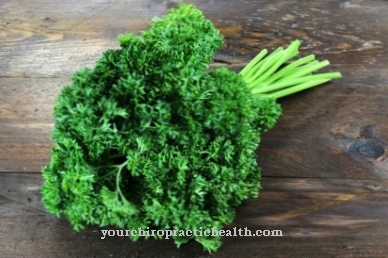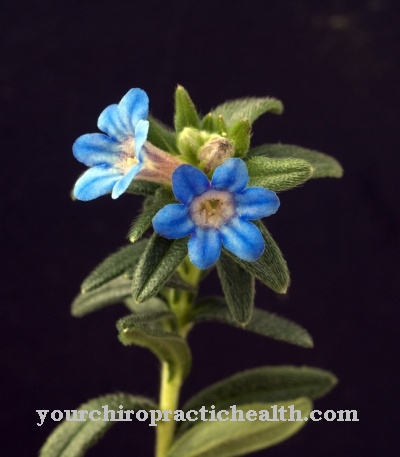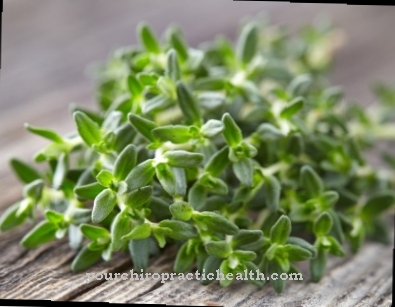Occurrence & cultivation of the goldenrod

Under the term Goldenrods around 100 different species are grouped together. The herbaceous plant reaches a height of around 1 m and is very persistent. The stem can be smooth or hairy and is usually very upright. The alternate leaves can also be smooth or hairy. The goldenrod owes its name to the bright yellow inflorescences.
Countless small flower heads hold the small yellow flowers in rich umbels. The goldenrod belongs to the sunflower family and is suspected of causing hay fever. The pollen of the plant is quite sticky and clumsy and therefore cannot fly far. Most of the Solidago species grow in North America, although human help has allowed the plants to spread in Central Europe.
However, the real goldenrod, which is used for medicinal purposes, is native to Europe. The Canadian variant, however, has similar ingredients. The goldenrod prefers roadsides and dry forest meadows. The plant is perennial and appears again and again in the same location.
Effect & application
The ingredients of the goldenrod are very diverse. Various flavonoids, triterpene saponins and phenol glycosides are responsible for the effect. One of the most important active ingredients in the real goldenrod is leiocarposid. The kidney tissue in particular benefits from the healing and strengthening effect. The flavonoids stimulate the kidneys to excrete more fluid.
As a result, the urinary tract is better flushed out and bacteria have a harder time settling. Due to its draining effect, goldenrod can also be used for gout and rheumatism. To support the dehydrating effect, the body should be given plenty of fluids in the form of water or tea. Furthermore, the active ingredients are anti-inflammatory, antispasmodic and astringent.
Astringents act astringent and provide a protective layer over wounds and mucous membranes. This is beneficial for infections of the bladder and kidneys, as urination is often painful due to the irritated urinary tract. The saponins contained are also helpful for fungal infections. Goldenrod is also effective against candida infections, thrush and vaginal infections.
In this case, goldenrod can also be used as a rinse for the mouth or vagina. The medicinal plant can be used as a tea or in tablet form. Mixtures that optimize the diuretic effect are often offered in the trade as tea. Solidago is also available as drops and tinctures. The finished drugs with goldenrod should always be taken according to the manufacturer's instructions.
If the goldenrod is to be used as a tea, it is advisable to slowly bring the drug to the boil with cold water. Around two teaspoons with a quarter of a liter of water are used. The tea is only allowed to brew briefly, two minutes are sufficient. Three to five cups of tea are drunk throughout the day.
Importance for health, treatment & prevention
The goldenrod is a means that can be used in a variety of ways. Tea should therefore not be missing in any medicine cabinet. Since it is a mild remedy, even small children can be treated with it. However, treatment should be avoided if there is an existing allergy to composites. Goldenrod treatment should also be avoided if the heart and kidneys are not able to work properly.
Since no reliable results are available, treatment with goldenrod is not recommended during pregnancy and breastfeeding. Goldenrod is a very common ingredient in blood cleansing tea and can be used as part of a detox. If there is a tendency towards bladder stones and kidney gravel, goldenrod is traditionally also the method of choice. The effectiveness could so far only be proven in laboratory tests.
Nevertheless, there are numerous testimonials that support this theory. In the case of bladder infections, the flushing effect is in the foreground, but this is well supported by the anti-inflammatory active ingredients. It is also very worth knowing that the goldenrod does not disturb the electrolyte balance due to the increased water excretion, like many other dehydrating agents. The sodium, calcium and potassium levels are thus not unbalanced by the use of goldenrod.
For rheumatism and gout, goldenrod reduces inflammation and thereby also reduces the pain that arthritis brings with it. The goldenrod can also be used for gum inflammation. Mouthwashes are particularly helpful here. Goldenrod is also recommended for inflammation of the mucous membranes and purulent wounds, even if this application has been somewhat forgotten.
Gargling with goldenrod can also significantly improve sore throats. But the goldenrod can also be used preventively. The susceptibility to infection increases, especially in winter. Goldenrod tea is a very good prophylactic measure so that viral infections have no chance at all. Studies have shown anti-tumor properties.
That is why goldenrod can also be taken preventively if there are diseases of the prostate. Another area of application is problems in the gastrointestinal area. Goldenrod helps against diarrhea and is an effective remedy for gastrointestinal flu. Since goldenrod also has a mild antipyretic and antispasmodic effect, the tea is very helpful for such an infection.




























